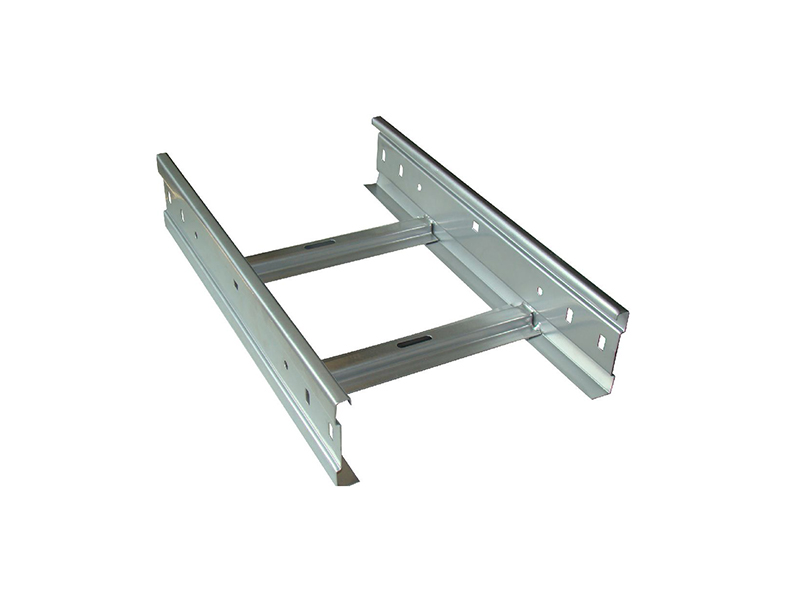济南苏鑫电缆桥架有限公司
客户咨询热线
0531-85767688
售后热线:15668327566
联系基地:山东省 德州市协同发展产业园D06幢
文章来源:https://www.sddlqj.cn/ 作者:电缆桥架厂家发布时间:2025-06-05 浏览次数:1
电缆桥架作为电力传输系统的关键载体,其散热性能直接影响电缆载流量与使用寿命。在选购过程中,科学评估桥架散热能力,需结合理论参数与实测数据,建立多维评价体系。
As a key carrier of power transmission systems, the heat dissipation performance of cable trays directly affects the cable current carrying capacity and service life. In the selection process, scientifically evaluating the heat dissipation capacity of the bridge frame requires the establishment of a multidimensional evaluation system based on theoretical parameters and measured data.
散热性能的核心影响因素
The core influencing factors of heat dissipation performance
桥架散热效能取决于材质导热系数、结构形式及表面处理工艺。铝合金桥架导热系数达237W/(m·K),是镀锌钢桥架的3倍以上,但需注意其线膨胀系数较高,需预留补偿间隙。开放式网格桥架通风面积占比超70%,散热效率比封闭式槽盒提升40%,但防护等级相应降低。表面阳极氧化处理可提升辐射散热能力,发射率从0.2(裸金属)提升0.8,加速热量交换。
The heat dissipation efficiency of the bridge depends on the material's thermal conductivity, structural form, and surface treatment process. The thermal conductivity of aluminum alloy bridge frame reaches 237W/(m · K), which is more than three times that of galvanized steel bridge frame. However, it should be noted that its linear expansion coefficient is relatively high, and compensation gap needs to be reserved. The ventilation area of open grid cable trays accounts for over 70%, and the heat dissipation efficiency is 40% higher than that of closed trough boxes, but the protection level is correspondingly reduced. Surface anodizing treatment can enhance radiation heat dissipation capability, increase emissivity from 0.2 (bare metal) to 0.8, and accelerate heat exchange.
实验室检测关键指标
Key indicators for laboratory testing
权威检测机构通过三项核心试验评估散热性能:热阻测试采用ASTM D5470标准,在桥架表面施加1000W/m²热流密度,测量内外壁温差计算热阻值,产品热阻应低于0.5K·m²/W。温升试验模拟满载工况,将桥架置于35℃环境舱内,通入1.5倍额定电流,2小时后本体温度不得超过环境温度60℃。热循环试验则通过-20℃80℃的100次温度冲击,验证结构稳定性,变形量需控制在0.2%以内。
Authoritative testing institutions evaluate the heat dissipation performance through three core tests: the thermal resistance test adopts ASTM D5470 standard, applies a heat flux density of 1000W/m ² on the surface of the bridge, measures the temperature difference between the inner and outer walls to calculate the thermal resistance value, and the thermal resistance of high-quality products should be less than 0.5K · m ²/W. The temperature rise test simulates the full load condition, placing the bridge in a 35 ℃ environmental chamber and applying 1.5 times the rated current. After 2 hours, the body temperature should not exceed 60 ℃ of the ambient temperature. The thermal cycling test verifies the stability of the structure through 100 temperature shocks ranging from -20 ℃ to 80 ℃, with deformation controlled within 0.2%.
现场快速评估方法
On site rapid assessment method
选购时可采用三项实操检测:红外热成像检测需在桥架样品通入额定电流,使用热像仪扫描表面,热点温差超过10℃则表明结构存在散热盲区。通风量测试采用风速仪,在桥架开口处测量自然对流风速,开放式桥架应达0.5m/s以上。接触热阻检测需在连接片与桥架本体间放置导热硅脂片,施加10N·m扭矩后,使用毫欧表测量接触电阻,应低于5mΩ。
When making a purchase, three practical tests can be used: infrared thermal imaging testing requires applying rated current to the bridge sample, using a professional thermal imager to scan the surface, and if the temperature difference between hot spots exceeds 10 ℃, it indicates that there is a heat dissipation blind spot in the structure. The ventilation test adopts an anemometer to measure the natural convection wind speed at the opening of the bridge, and the open bridge should reach 0.5m/s or above. Contact thermal resistance detection requires placing a thermal conductive silicone grease sheet between the connecting piece and the bridge body, applying a torque of 10N · m, and measuring the contact resistance with a milliohmmeter, which should be less than 5m Ω.

特殊场景专项考量
Special considerations for special scenarios
高温环境需选择具有UL2580认证的耐高温桥架,其硅橡胶密封条可耐受180℃持续高温。大电流场景应关注桥架宽度与电缆填充率的关系,当填充率超过40%时,需选用加宽型桥架或增设散热隔板。对于密集敷设区域,建议采用梯级式桥架配合导流板设计,强制空气对流,实测散热效率可提升25%。
High temperature environments require the selection of UL2580 certified high-temperature resistant cable trays, whose silicone rubber sealing strips can withstand sustained high temperatures of up to 180 ℃. In high current scenarios, attention should be paid to the relationship between cable tray width and cable filling rate. When the filling rate exceeds 40%, widened cable trays or additional heat dissipation partitions should be selected. For densely laid areas, it is recommended to use a stepped bridge structure with a guide plate design to force air convection, which can increase the measured heat dissipation efficiency by 25%.
选购决策数据支撑
Purchase decision data support
需向供应商索取第三方检测报告,关注三项核心数据:长期载流量修正系数,桥架在40℃环境下载流量仅降低15%,劣质产品可能下降30%以上。热时间常数反映升温速率,该值越小表明响应越快,铝合金桥架通常在200秒以内。年温升衰减率需低于5%,确保长期使用后散热性能不显著下降。
We need to request a third-party testing report from the supplier, with a focus on three core data points: long-term current carrying capacity correction coefficient. High quality cable trays only reduce download capacity by 15% in a 40 ℃ environment, while inferior products may experience a reduction of over 30%. The thermal time constant reflects the heating rate, and the smaller the value, the faster the response. Aluminum alloy cable trays are usually within 200 seconds. The annual temperature rise attenuation rate should be less than 5% to ensure that the heat dissipation performance does not significantly decrease after long-term use.
安装规范对散热的影响
The impact of installation specifications on heat dissipation
即使桥架本体散热性能优异,不规范安装也会导致效能损失。层间垂直间距需保持200mm以上,水平间距不小于50mm,形成自然烟囱效应。转角处需采用45°拼接替代直角弯头,减少气流阻力。对于长距离敷设,每30米应增设强制通风装置,在桥架底部开设进风孔,顶部安装轴流风机,形成垂直风道。
Even if the heat dissipation performance of the bridge body is excellent, non-standard installation can still lead to performance loss. The vertical spacing between layers should be kept at least 200mm, and the horizontal spacing should not be less than 50mm to create a natural chimney effect. 45 ° splicing should be used at the corner instead of right angle elbows to reduce airflow resistance. For long-distance installation, a forced ventilation device should be installed every 30 meters, with air inlet holes at the bottom of the bridge and axial flow fans installed at the top to form a vertical air duct.
本文由山东电缆桥架友情奉献.更多有关的知识请点击:http://www.sddlqj.cn我们将会对您提出的疑问进行详细的解答,欢迎您登录网站留言.
This article is a friendly contribution from Shandong Cable Bridge For more information, please click: http://www.sddlqj.cn We will provide detailed answers to your questions. You are welcome to log in to our website and leave a message
 200山东电缆桥架能放多少根电线
200山东电缆桥架能放多少根电线
200mm宽的电缆桥架能容纳的电缆数量取决于多个因素,包括电缆类型、填充率、布置方式以及散热和维护要求。以下是关键计算要点: The number of cables that a 200mm
TIME:2025-12-19